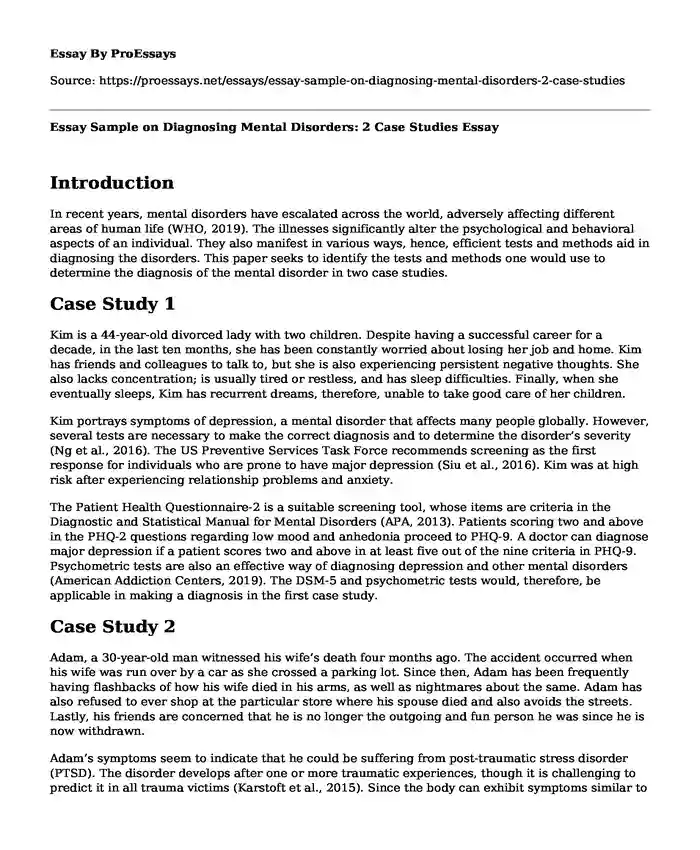Introduction
In recent years, mental disorders have escalated across the world, adversely affecting different areas of human life (WHO, 2019). The illnesses significantly alter the psychological and behavioral aspects of an individual. They also manifest in various ways, hence, efficient tests and methods aid in diagnosing the disorders. This paper seeks to identify the tests and methods one would use to determine the diagnosis of the mental disorder in two case studies.
Case Study 1
Kim is a 44-year-old divorced lady with two children. Despite having a successful career for a decade, in the last ten months, she has been constantly worried about losing her job and home. Kim has friends and colleagues to talk to, but she is also experiencing persistent negative thoughts. She also lacks concentration; is usually tired or restless, and has sleep difficulties. Finally, when she eventually sleeps, Kim has recurrent dreams, therefore, unable to take good care of her children.
Kim portrays symptoms of depression, a mental disorder that affects many people globally. However, several tests are necessary to make the correct diagnosis and to determine the disorder’s severity (Ng et al., 2016). The US Preventive Services Task Force recommends screening as the first response for individuals who are prone to have major depression (Siu et al., 2016). Kim was at high risk after experiencing relationship problems and anxiety.
The Patient Health Questionnaire-2 is a suitable screening tool, whose items are criteria in the Diagnostic and Statistical Manual for Mental Disorders (APA, 2013). Patients scoring two and above in the PHQ-2 questions regarding low mood and anhedonia proceed to PHQ-9. A doctor can diagnose major depression if a patient scores two and above in at least five out of the nine criteria in PHQ-9. Psychometric tests are also an effective way of diagnosing depression and other mental disorders (American Addiction Centers, 2019). The DSM-5 and psychometric tests would, therefore, be applicable in making a diagnosis in the first case study.
Case Study 2
Adam, a 30-year-old man witnessed his wife’s death four months ago. The accident occurred when his wife was run over by a car as she crossed a parking lot. Since then, Adam has been frequently having flashbacks of how his wife died in his arms, as well as nightmares about the same. Adam has also refused to ever shop at the particular store where his spouse died and also avoids the streets. Lastly, his friends are concerned that he is no longer the outgoing and fun person he was since he is now withdrawn.
Adam’s symptoms seem to indicate that he could be suffering from post-traumatic stress disorder (PTSD). The disorder develops after one or more traumatic experiences, though it is challenging to predict it in all trauma victims (Karstoft et al., 2015). Since the body can exhibit symptoms similar to those in PTSD due to other conditions, the diagnosis of PTSD relies on criteria in the DSM-5 (Tull, 2019). However, apart from the manual, a health practitioner can also carry out a psychological evaluation, as an additional diagnostic tool.
The DSM-5 criteria for PTSD consist of eight categories, with several symptoms in each criterion (APA, 2013). The diagnosis of PTSD occurs when a patient experiences all the symptoms in criteria A, F, G, and H, in addition to one or two symptoms in each of the other criteria. Adam’s situation has met the requirements for DSM-5, as he directly witnessed his wife’s death; his social life was affected and had persistent flashbacks about the accident.
Conclusion
In conclusion, mental disorders have escalated and adversely affected human life in recent years. The two case studies show individuals suffering from two mental disorders; major depression and PTSD respectively. The most suitable diagnostic tools and methods in the cases involve screening, the DSM-5 criteria, and psychological or psychometric evaluation.
References
American Addiction Centers (2019, September 13). A List of Tests and Assessments to Diagnose Mental Health Disorders. Desert Hope. https://deserthopetreatment.com/co-occurring-disorders/tests-and-assessments/
American Psychiatric Association. (2013). Diagnostic and statistical manual of mental disorders (DSM-5®). American Psychiatric Pub.
Karstoft K, Galatzer-Levy IR, Statnikov A, Li Z, Shalev AY. Bridging a translational gap: using machine learning to improve the prediction of PTSD. BMC Psychiatry 2015;15:30.
Ng, C. W. M., How, C. H., & Ng, Y. P. (2016). Major depression in primary care: making the diagnosis. Singapore Medical Journal, 57(11), 591.
Siu, A. L., Bibbins-Domingo, K., Grossman, D. C., Baumann, L. C., Davidson, K. W., Ebell, M., ... & Krist, A. H. (2016). Screening for depression in adults: US Preventive Services Task Force recommendation statement. Jama, 315(4), 380-387.
Tull, M. (2019, June 19). Symptoms and Diagnosis of PTSD. Very well mind. https://www.verywellmind.com/requirements-for-ptsd-diagnosis-2797637
World Health Organization. (2019, November 28). https://www.who.int/news-room/fact-sheets/detail/mental-disorders
Cite this page
Essay Sample on Diagnosing Mental Disorders: 2 Case Studies. (2023, Oct 21). Retrieved from https://proessays.net/essays/essay-sample-on-diagnosing-mental-disorders-2-case-studies
If you are the original author of this essay and no longer wish to have it published on the ProEssays website, please click below to request its removal:
- Reflection on TED Talk by Vern Myers Essay
- The Opioid Crisis in Red Hill - Essay Sample
- Nurses' Mental and Physical Health: Challenges and Implications - Research Paper
- Essay Sample on Mental Disorders: Exploring Other Approaches for Improving Thinking
- Paper Example on Young and Driven: The Nursing Career Path
- Essay on Overcoming Resistance to Change: An Example From Kegan and Lahey (2001)
- Paper Sample on Highly Stressed: Psychological Stress in People Living with HIV/AIDS in the US South







